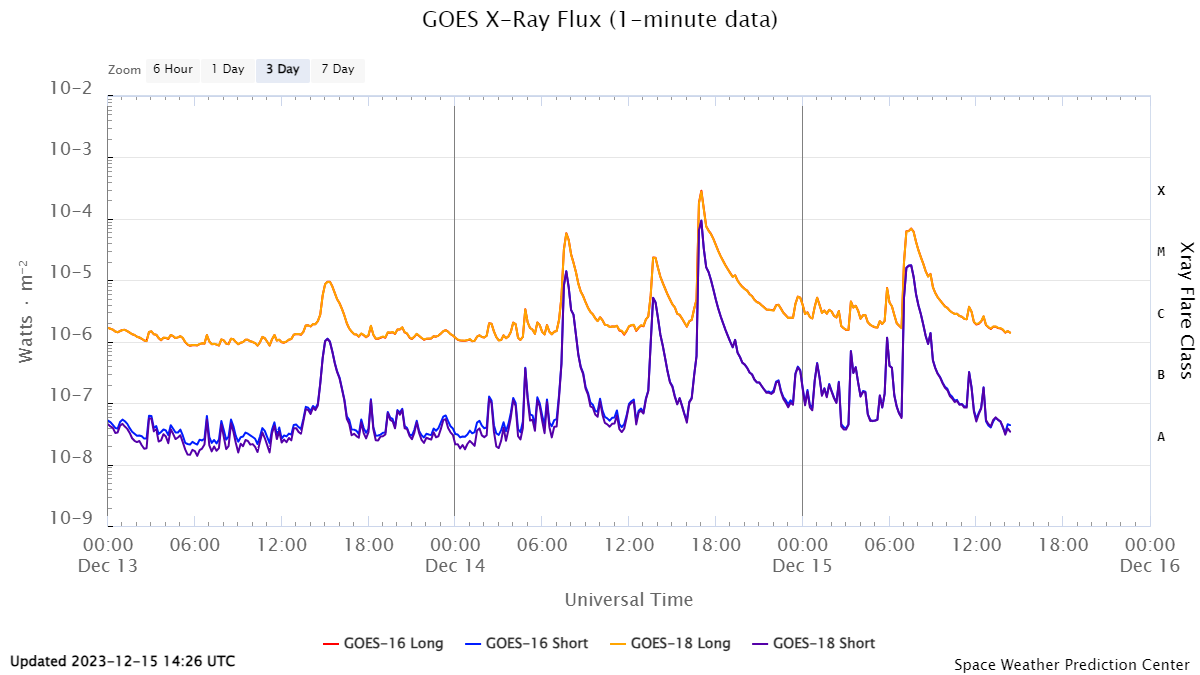Geomagnetic storm forecast - 15th December 2023
What Has Happened?
Complex active region 13514, located in the northwestern edge of the solar disc, produced a powerful X2.8 solar flare on the 14th December, peaking at 17:02 UT. This flare is the strongest in this solar cycle, and the largest seen in the last six years. The associated coronal mass ejection (CME) is an asymmetric full-halo, with the bulk of the ejecta heading away from Earth. Modelling suggests that a glancing blow from the CME could arrive late on the 16th, or early on the 17th December.
The strength of any geomagnetic storm depends on the nature of the CME impact; what proportion of the CME is Earth-directed, and the strength and direction of the interplanetary magnetic field contained in the CME. A geomagnetic storm is predicted, and activity could range from STORM G1 to potentially STORM G3, if the impact is significant.
Active region 13514 has also produced several C- and M-class solar flares over the past week, some with associated coronal mass ejections. A CME arrival from one of these smaller events arrived at Earth 11:46 UT on 15th December and we could see ACTIVE to STORM G1 effects in the hours following. Other CMEs associated with M-class flare events may combine with the CME associated with the X2.8 event.
Assuming clear, cloud-free, dark skies, there is an increased chance of seeing the aurora on 16th and 17th December. Those in Scotland, northern England and Northern Ireland have the best chance if the weather and timing of the CME arrivals is favourable.
Sign-up to receive Geomagnetic Disturbance Alert emails.
Follow us on Twitter:
Follow @BGSauroraAlert for more occasional aurora alerts.
Follow @BGSspaceWeather for daily space weather forecasts.
Glossary
- BGS
- The British Geological Survey is a geoscience research centre that is part of UK Research and Innovation (UKRI) and affiliated to the Natural Environment Research Council (NERC).
- CME or Coronal Mass Ejection
- The eruption of a portion of the outer atmosphere of the Sun into space, caused by rapid changes in its magnetic field. Often occurs along with a solar flare.
- Solar Wind
- The ever-present expansion of the Sun’s hot outer atmosphere into the solar system, which carries space weather within it.
- Filament Eruption
- An eruption of solar plasma (i.e. ions and electrons) associated with the upward movement of solar magnetic field lines into the corona. Filaments are usually dark against the bright solar disk but can appear bright (as 'erupting prominences') on the limbs of the Sun against the darkness of space. Filaments are often associated with CMEs
- Solar Flare
- Energy released by the explosive reorganisation of magnetic fields within the Sun's atmosphere.
- Sunspot/Active Region
- A region of intense magnetic field in the Sun's visible outer atmosphere often associated with flares and CMEs.



